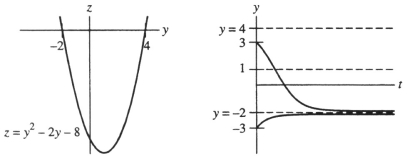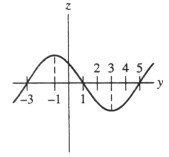B) False
Correct Answer

verified
Correct Answer
verified
True/False
Given the differential equation with the given initial condition: is this the solution
B) False
Correct Answer

verified
Correct Answer
verified
Multiple Choice
Let f(t) be the solution of = t + y + , f(0) = 2. If Euler's method with n = 4 is used to approximate f(t) for find f .
A) 2(4 + )
B) + y +
C)
D) 3 +
E) none of these
G) C) and D)
Correct Answer

verified
Correct Answer
verified
Multiple Choice
Consider the differential equation y' = y - . Which of the following statements is/are true?
A) The function f(t) = is a solution to this differential equation with initial condition
B) This differential equation has infinitely many solutions.
C) The constant function f(t) = 1 is a solution to this differential equation.
D) If f(t) is a solution to the differential equation satisfying the initial condition y(0) = 0, then
E) All of these statements are true.
G) A) and D)
Correct Answer

verified
Correct Answer
verified
Multiple Choice
Solve the differential equation with the given initial condition. -
A) y = 4 -
B) y =
C) y = +
D) y = 4 +
F) None of the above
Correct Answer

verified
Correct Answer
verified
Multiple Choice
Which of the following is a sketch of the solution of = - 9; y(0) = 2 ?
A) ![]()
B) ![]()
C) ![]()
D) ![]()
F) B) and C)
Correct Answer

verified
Correct Answer
verified
True/False
Given the differential equation: , is this the solution
B) False
Correct Answer

verified
Correct Answer
verified
Multiple Choice
Find the integrating factor, the general solution, and the particular solution satisfying the initial condition. - 4y = -2 ; y(0) = -1
A) integrating factor:
General solution:
Particular solution: y = - - 2
B) integrating factor:
General solution: y = + C
Particular solution: y = - 2
C) integrating factor:
General solution: y = -2t + C
Particular solution: y = -2t -
D) integrating factor:
General solution: y = + C
Particular solution: y = -
Solve the equation using an integrating factor.
F) C) and D)
Correct Answer

verified
Correct Answer
verified
Multiple Choice
Solve the initial value problem using an integrating factor. -t + 3y = 5t; , t > 0
A) y = t -
B) y = + 1 -
C) y = 5 - 4t
D) y = 5 - 4
F) All of the above
Correct Answer

verified
Correct Answer
verified
Multiple Choice
Suppose that a substance A is converted to substance B at a rate that is proportional to the cube of the amount of B present. The amount of A and B together is always constant, say M. If f( t) = y is the amount of A present at time t, then which of the following differential equation describes the situation?
A) = ; k < 0
B) = ; k > 0
C) = ; k > 0
D) = ; k < 0
E) none of these
G) All of the above
Correct Answer

verified
Correct Answer
verified
True/False
One or more initial conditions are given for the differential equation. Use the qualitative theory of autonomous differential equations to sketch the graphs of the corresponding solution. Include a yz-graph as well as a ty-graph. Do these graphs represent the situation? 
B) False
Correct Answer

verified
Correct Answer
verified
True/False
Consider the differential equation = g(y) where g(y) is the function whose graph is shown below:  Indicate whether the following statements are true or false.
-If the initial value of y(0) is 2, then the corresponding solution has an inflection point.
Indicate whether the following statements are true or false.
-If the initial value of y(0) is 2, then the corresponding solution has an inflection point.
B) False
Correct Answer

verified
Correct Answer
verified
Short Answer
Use Euler's method with n = 2 to approximate the solution f(t) to Estimate f(1). Enter just a reduced fraction of form .
Correct Answer

verified
Correct Answer
verified
True/False
Combine the terms y and into the derivative of a product, then solve the equation. . Is this the solution:
B) False
Correct Answer

verified
Correct Answer
verified
True/False
A certain drug is introduced into a person's bloodstream. Suppose that the rate of decrease of the concentration of the drug in the blood is directly proportional to the product of two quantities: (a) the amount of time elapsed since the drug was introduced, and (b) the square of the concentration. Let y = f(t) denote the concentration of the drug in the blood at time t. Set up a differential equation satisfied by f(t). Does the following accurately describe this situation:
B) False
Correct Answer

verified
Correct Answer
verified
True/False
Consider the differential equation = g(y) where g(y) is the function whose graph is shown below:  Indicate whether the following statements are true or false.
-y = -3, y = 1, and y = 5 are the constant solutions to = g(y).
Indicate whether the following statements are true or false.
-y = -3, y = 1, and y = 5 are the constant solutions to = g(y).
B) False
Correct Answer

verified
Correct Answer
verified
Multiple Choice
v -An initial deposit of $8,000 is made into an account earning 6.5% compounded continuously. Thereafter, money is deposited into the account at a constant rate of $2600 per year. Find the amount in this account at any time t. How much is in this account after 5 years?
A) A = 60,000 - 52,000= $31,041.84
B) A = 52,000 - 44,000= $27,969.59
C) A = 48,000 - 40,000= $26,433.47
D) A = 44,000 - 36,000= $24,897.34
F) B) and C)
Correct Answer

verified
Correct Answer
verified
True/False
A savings account earns 6% annual interest, compounded continuously. An initial deposit of $8500 is made, and thereafter money is withdrawn continuously at the rate of $480 per year. Does the following accurately represent this situation:
B) False
Correct Answer

verified
Correct Answer
verified
Multiple Choice
Which of the following functions solves the differential equation:
A) y = + 3
B) y = + 3
C) y = - + 3x
D) none of these
F) A) and B)
Correct Answer

verified
Correct Answer
verified
Multiple Choice
Solve the differential equation with the given initial condition. -
A) y = ln + 1
B) y = + 1
C) y = tan t + 1
D) y = +
F) A) and B)
Correct Answer

verified
Correct Answer
verified
Showing 41 - 60 of 126
Related Exams